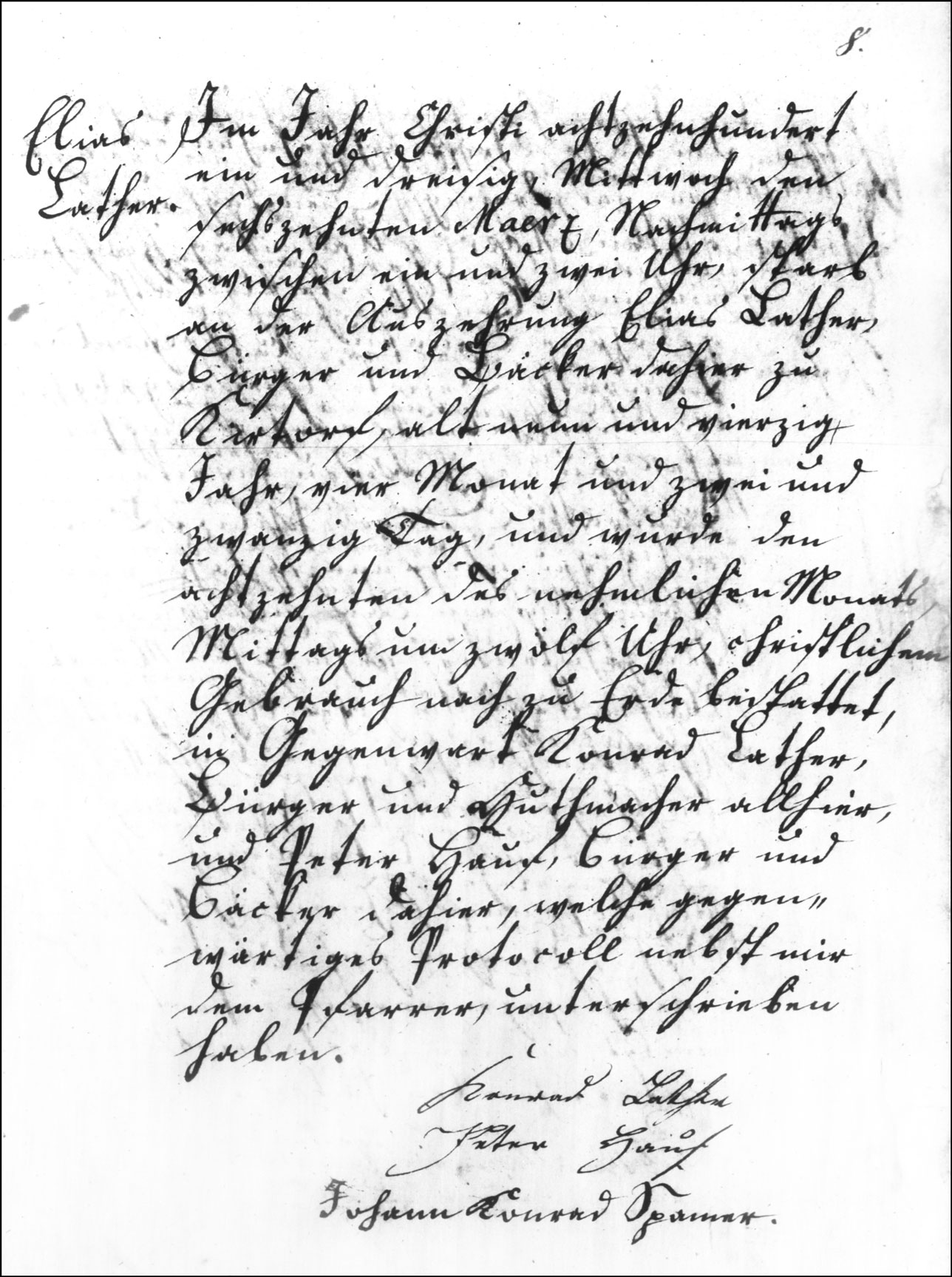On 17 Mar 1831, Elias Lather died of consumption (tuberculosis) in Kirtorf, Alsfeld Kreis, Hessen-Darmstadt (now Germany). He was buried in Kirtorf, Alsfeld Kreis, Hessen-Darmstadt (now Germany) on 19 Mar 1831.
The Death and Burial Record of Elias Lather – 1831
SOURCE: Kirtorf Evangelische Kirche (Kirtorf, Alsfeld Kreis, Hessen-Darmstadt), “Sterb=Protokoll der Pfarrei Kirtorf fí¼r das Jahr 1831. [Death Records of the Kirtorf Parish for the Year 1831.],” page 8, Elias Lather, 18 March 1822; filmed as Kirchenbuchduplikat 1808-1875; FHL INTL microfilm 0,855,111.
Click on the image above to enlarge it. Click on the link for a PDF copy of the Death and Burial Record of Elias Lather. This PDF document includes an image of the original document, a transcription in German Gothic, a transcription in modern German, and a translation in English. Translated from the German, the record reads:
8.
Elias LatherBetween one and two o’clock in the afternoon on Wednesday, the seventeenth of March, in the year of the Lord eighteen-hundred thirty-one, Elias Lather, citizen and baker here in Kirtorf, forty-nine years four months and twenty-two days old, died of consumption, and was buried in the earth according to Christian custom at twelve o’clock noon on the eighteenth of the above-mentioned month, in the presence of Konrad Lather, citizen and milliner here, and Peter Haus, citizen and baker here, who have signed the present document next to me, the minister.
         [signed] Konrad Lather
         [signed] Peter Haus
         [signed] Johann Konrad Spamer
Elias Lather was apparently the father of Johann Georg Lather and Henrich Lather.
Copyright © 2009 by Stephen J. Danko





Steve,
It seemed but a few days I took my eye off your blog – so much has happened…
Hearty congratulations on your well deserved ProGenealogists’ Award. I have to admit to one of my favourite entries (apart from your, to me, irresistable translations of Polish and Cyrillic records) has been your interview with Schelly Talalay Dardashti, leading to my following of her blog also.
What a powerhouse your FHC must be. I’m sure you deserved the good fortune of having Heike at hand in your hour of need. How do you then manage to so, seemingly easily, translate subsequent German entries in Gothic? To a non-linguist (me) this appears nigh on misaculous!! I’ve been lucky that my German records have all been in tabular form; I suspect the word ‘Napoleonic’ must creep in here somewhere, as well as location at the time, but is it possible for you to comment please on why these ‘GERMAN’ entries are in narrative format, which is of course what I expect in my Polish and Cyrillic records from the Kingdom of Poland?
Lastly(!) how many records have you found in both Polish and Russian? Were these two Registers held as parallel Church records, and a third Cyrillic copy submitted to the authorities?
Long may your blogging enthusiasm continue Steve, even if I cannot comprehend where you find the energy to maintain this pace! Bron.
Hi Bronwyn,
Thanks for your kind words. I’m not sure I’d call my FHC a powerhouse! The place is tiny and, on most days, there are only two or three patrons there. The volunteers and patrons do, however, appear to be very knowledgeable.
As for my apparent ease at translating the German Gothic script, I have to admit that I did study German in high school and college, and I just recently completed a course in reading Gothic script through the National Institute for Genealogical Studies. Like the Polish and Russian records, the records in Kirtorf from 1808-1875 all follow the same formula. I just needed soemone to translate one record and everything else turned out to be similar to that first record!
In 1801, Hessen-Darmstadt established a friendly relationship with Napoleon and, in 1806, Hessen-Darmstadt joined Napoleon’s Confederation of the Rhine. As you know, Napoleon was responsible for the establishment of civil registration across much of Europe. The microfilms I’ve been examining from Kirtorf are the civil registration copies of the parish records and, as you noticed, the format is what you and I would call “Napoleonic”. I don’t know whether or not this format was common throughout Hessen-Darmstadt.
I have only found both Polish and Russian language copies of the same records in two parishes in Poland. In one parish, the Russian version was on the left page and the Polish version was on the right page of the same volume. In the other parish, it appears that the Polish version was the church copy and the Russian version was the civil registration copy.
Steve
Steve,
Thank you for your detailed comments.
It seems to me as though the Church where their copy of the register was kept in Polish and a Cyrillic duplicate submitted as the Civil version to the authorities had a rather brave Priest!! It is fantastic to be able to see these records in both languages.
You look like having an interesting collection of documents in German so your course in reading Gothic script was a wise investment.
Kind regards,
Bronwyn.